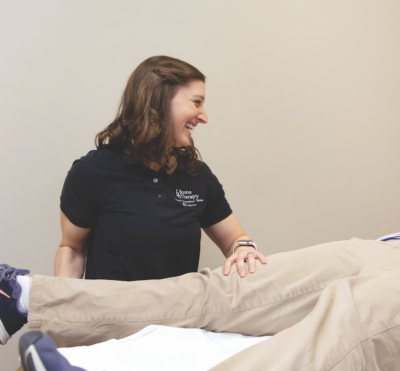
A common problem
By Tiffany Schmidt
The pelvic floor is a group of muscles which supports the pelvic organs. “The pelvic floor controls the bladder and bowels, and supports the uterus. When the muscles in the pelvis relax, the pelvic organs are able to pass waste. For women, it is especially important to maintain strong pelvic muscles.
Suzanne Price had experienced pelvic floor issues in the past. Her main symptom was a high frequency of needing to use the restroom, which would impede her day-to-day activities. “You just feel like you have to go to the bathroom all the time,” says Suzanne. These symptoms weren’t new to Suzanne, as she had a past history of pelvic floor issues. A physician suggested Suzanne try physical therapy.
Pelvic floor dysfunction occurs when the body is unable to control the contracting or relaxing of the pelvic floor muscles. “Some women don’t have enough muscle tone, so they will experience issues; however, my issue was that I actually had too much muscle tone, so I was having pelvic floor spasms which mimic a urinary tract infection,” Suzanne explains.
The 10-week process started this past August. Suzanne had visited Boone Therapy before, but was impressed with the new techniques she was taught: “Nicole was very hands on. She’d show me how to do things and then I would try to do them on my own within the therapy session.”
For Suzanne it wasn’t so much the strengthening of muscles but the full relaxation. She and her physical therapist, Nicole Tunink, PT, DPT, would focus on breathing in conjunction with abdominal strengthening, as well as working on hip mobility including hamstring and hip adductor flexibility, and a lot of time relaxing her pelvic floor.
After the sessions, Suzanne would perform easy “homework” assignments based on what Nicole had taught her. She would then share the week’s results with Nicole so that she could make any adjustments to Suzanne’s therapy plan.
Suzanne’s therapy was unique in that Nicole would use an electrical stimulation machine during their therapy sessions. “You get hooked up to a machine and it will show the level of muscle tone. If it’s too high, they can set the machine for 10 minutes (or a given amount of time), and it will wear the muscles out. After that, you can see where you’ve relaxed.
“By the second session, I was already feeling relief,” says Suzanne. By the end of six weeks, her muscles were not as tense or tight, and she was able to complete her daily routines unbothered. Nicole also walked her through strengthening and abdominal stretching techniques that she could continue to do on her own. “It really comes down to self-care,” says Suzanne.
The program was recently brought back to Boone Therapy to give women options to manage their discomfort. “Pelvic floor dysfunction is not commonly referred, but it is a common problem,” says Nicole. “Many women that have had kids, or even those who haven’t have some kind of pelvic floor dysfunction or urinary incontinence.”
Pelvic floor dysfunction may be an uncomfortable subject for some women, yet, “The people who do talk about it and get care for it are so happy that they did,” says Outpatient Therapy Supervisor, Ingrid Minge MBA, PT, DPT.
There is no limit to diagnoses at the Women’s Therapy Center. “If someone is uncomfortable with how their pain, bladder, or bowel functions are affecting their life, I’ll chat with them to see how I can help,” says Nicole.